Abstract
In previous studies, we showed that blood monocyte elaboration of interleukin 1 (IL-1), a known stimulator of bone resorption, was higher in osteoporotic patients with rapid bone turnover than in those with slow turnover and in nonosteoporotic subjects. Since an acceleration of bone loss following menopause contributes to the risk of osteoporosis in women, we have studied the effects of menopause and ovarian steroid treatment on IL-1 release by monocytes obtained from nonosteoporotic and osteoporotic women. IL-1 activity in the monocyte culture medium derived from untreated postmenopausal women (nonosteoporotic and osteoporotic) was higher than in the medium derived from either untreated premenopausal or estrogen/progesterone-treated postmenopausal women. A significant negative correlation was found between IL-1 and years since menopause in both the healthy (r = -0.75; P less than 0.005) and the osteoporotic (r = -0.61; P less than 0.01) untreated postmenopausal women. The difference between the two slopes was significant at P less than 0.05. Premenopausal IL-1 levels were achieved within 8 years of menopause in the nonosteoporotic, but not in the osteoporotic, subjects in whom increases were evident as long as 15 years after menopause. IL-1 also correlated inversely with vertebral mineral density (r = -0.37; P less than 0.05), as measured by quantitative computed tomography. In prospective studies, treatment with estrogen/progesterone for 1 month caused a substantial highly significant decrease in IL-1 activity in each of three nonosteoporotic and five osteoporotic women, confirming the apparent effect of hormone therapy observed in the cross-sectional analysis. Although a cause-effect relationship has not been established, it is our hypothesis, based on these data, that alterations in IL-1 production may underlie the postmenopausal acceleration in bone loss and its inhibition by ovarian steroids. Persistent elevation of IL-1 secretion appears to be a feature of postmenopausal osteoporosis.
Full text
PDF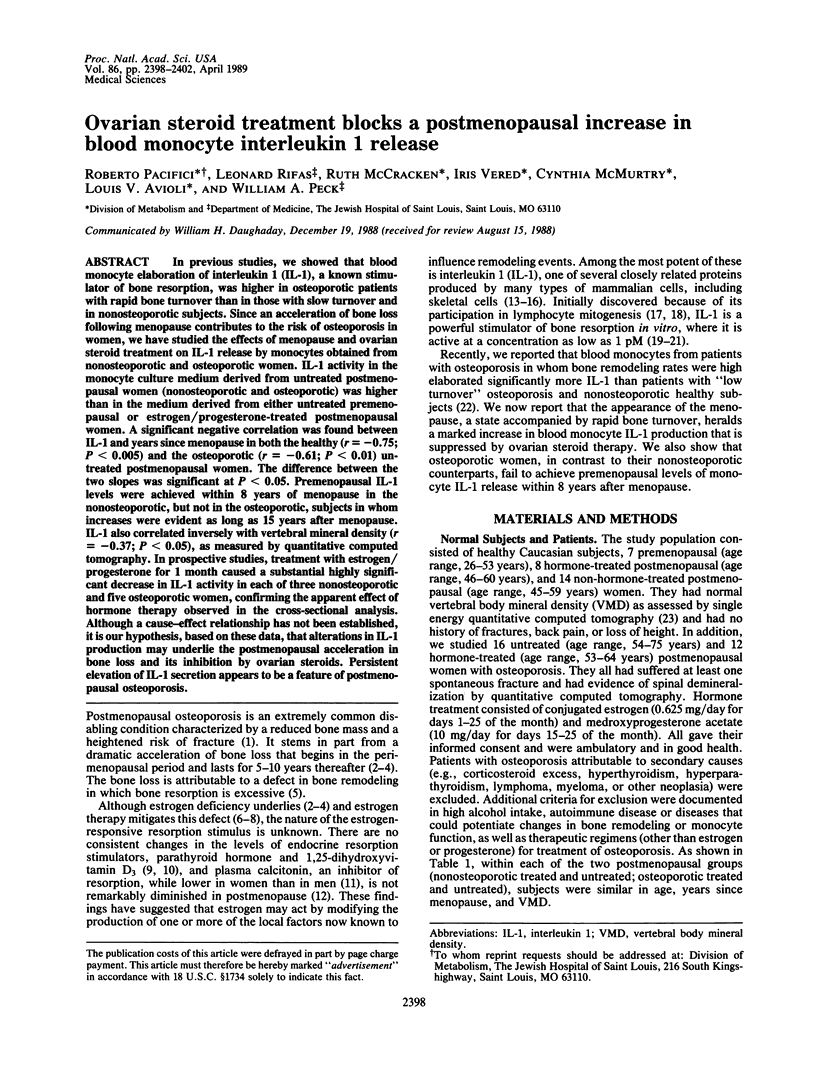
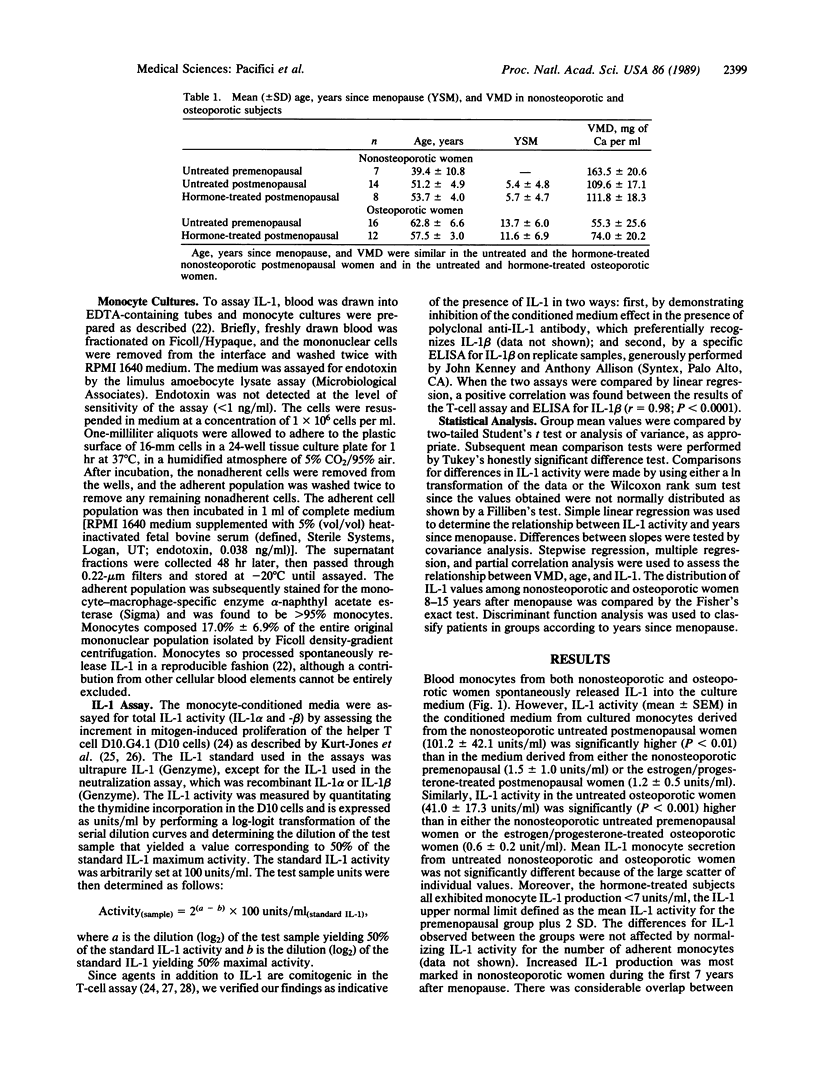
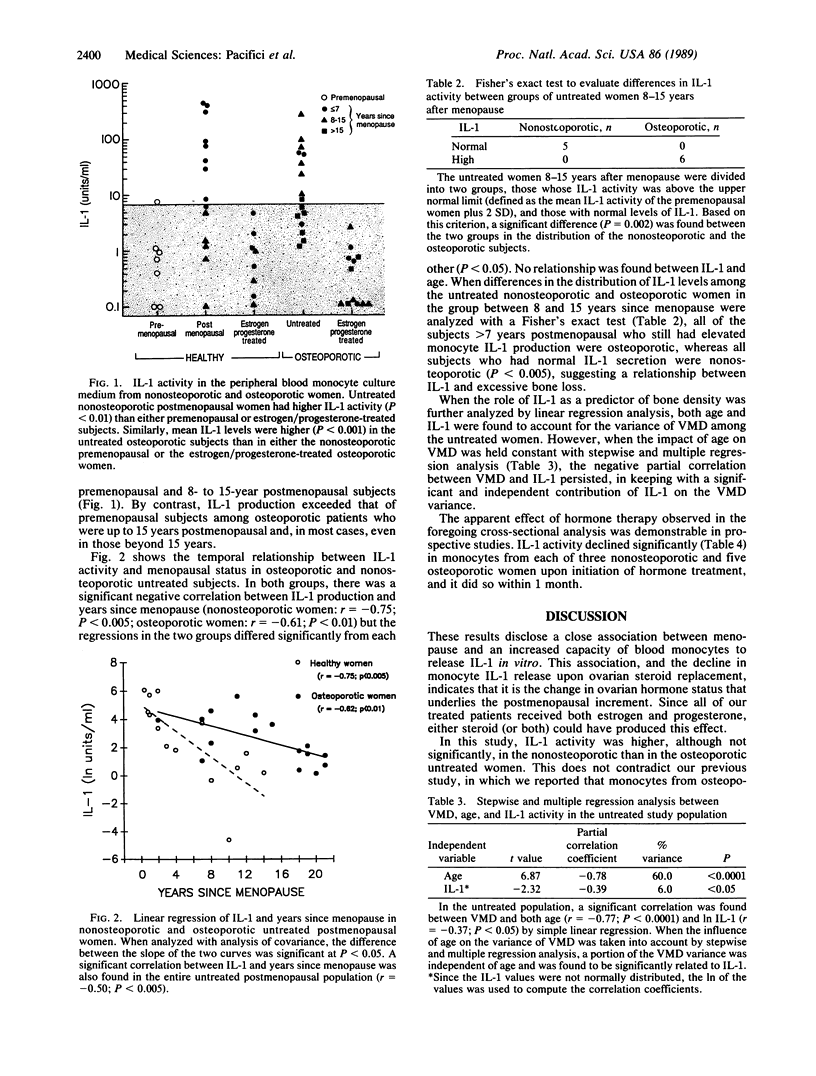
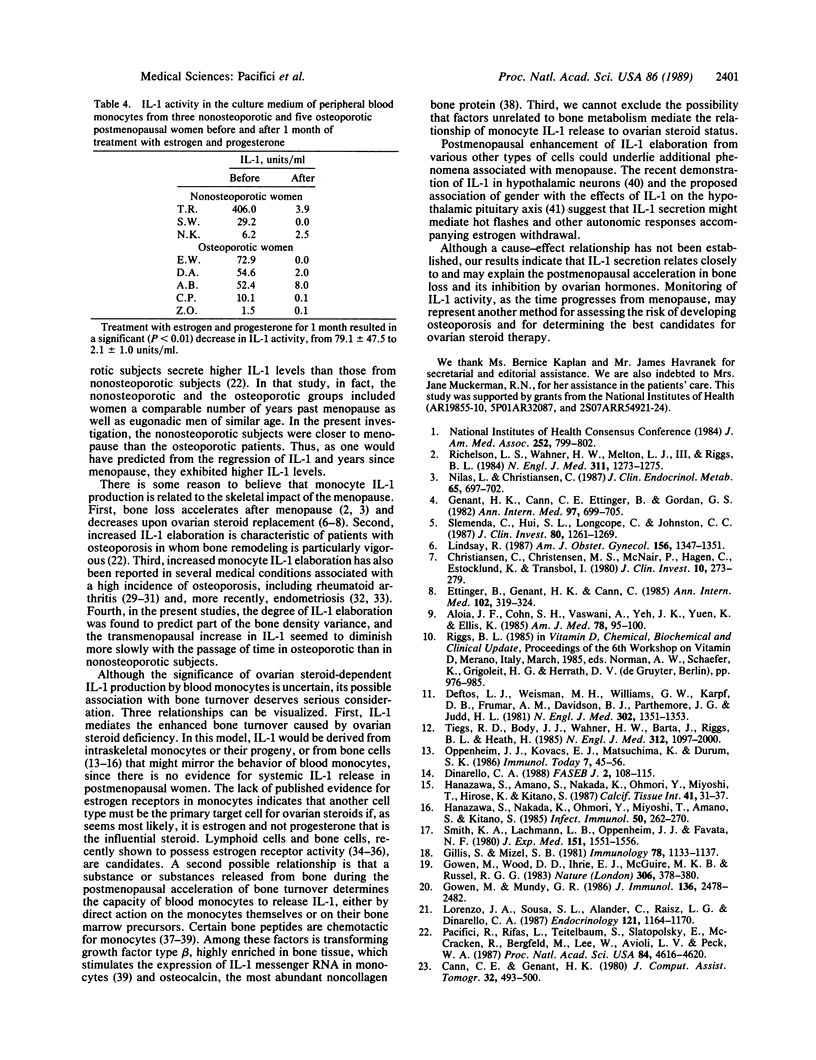
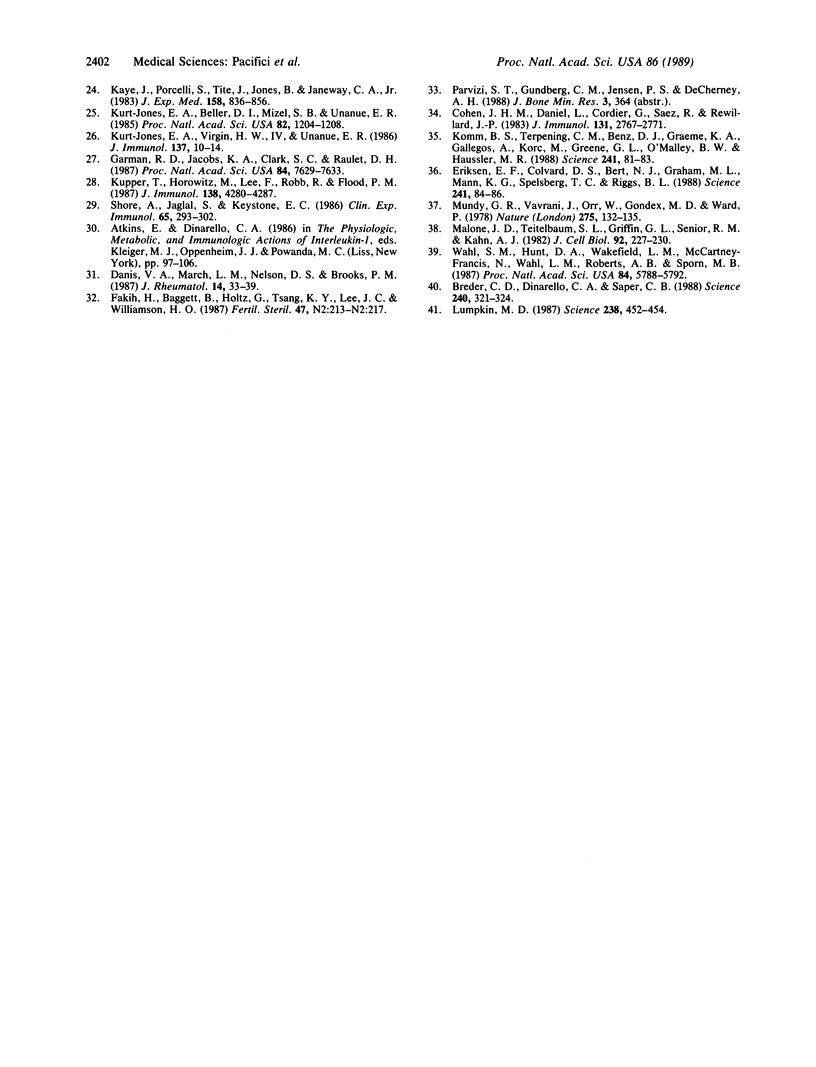
Selected References
These references are in PubMed. This may not be the complete list of references from this article.
- Aloia J. F., Cohn S. H., Vaswani A., Yeh J. K., Yuen K., Ellis K. Risk factors for postmenopausal osteoporosis. Am J Med. 1985 Jan;78(1):95–100. doi: 10.1016/0002-9343(85)90468-1. [DOI] [PubMed] [Google Scholar]
- Breder C. D., Dinarello C. A., Saper C. B. Interleukin-1 immunoreactive innervation of the human hypothalamus. Science. 1988 Apr 15;240(4850):321–324. doi: 10.1126/science.3258444. [DOI] [PubMed] [Google Scholar]
- Cann C. E., Genant H. K. Precise measurement of vertebral mineral content using computed tomography. J Comput Assist Tomogr. 1980 Aug;4(4):493–500. doi: 10.1097/00004728-198008000-00018. [DOI] [PubMed] [Google Scholar]
- Christiansen C., Christensen M. S., McNair P., Hagen C., Stocklund K. E., Transbøl I. Prevention of early postmenopausal bone loss: controlled 2-year study in 315 normal females. Eur J Clin Invest. 1980 Aug;10(4):273–279. doi: 10.1111/j.1365-2362.1980.tb00033.x. [DOI] [PubMed] [Google Scholar]
- Cohen J. H., Danel L., Cordier G., Saez S., Revillard J. P. Sex steroid receptors in peripheral T cells: absence of androgen receptors and restriction of estrogen receptors to OKT8-positive cells. J Immunol. 1983 Dec;131(6):2767–2771. [PubMed] [Google Scholar]
- Danis V. A., March L. M., Nelson D. S., Brooks P. M. Interleukin-1 secretion by peripheral blood monocytes and synovial macrophages from patients with rheumatoid arthritis. J Rheumatol. 1987 Feb;14(1):33–39. [PubMed] [Google Scholar]
- Deftos L. J., Weisman M. H., Williams G. W., Karpf D. B., Frumar A. M., Davidson B. J., Parthemore J. G., Judd H. L. Influence of age and sex on plasma calcitonin in human beings. N Engl J Med. 1980 Jun 12;302(24):1351–1353. doi: 10.1056/NEJM198006123022407. [DOI] [PubMed] [Google Scholar]
- Dinarello C. A. Biology of interleukin 1. FASEB J. 1988 Feb;2(2):108–115. [PubMed] [Google Scholar]
- Eriksen E. F., Colvard D. S., Berg N. J., Graham M. L., Mann K. G., Spelsberg T. C., Riggs B. L. Evidence of estrogen receptors in normal human osteoblast-like cells. Science. 1988 Jul 1;241(4861):84–86. doi: 10.1126/science.3388021. [DOI] [PubMed] [Google Scholar]
- Ettinger B., Genant H. K., Cann C. E. Long-term estrogen replacement therapy prevents bone loss and fractures. Ann Intern Med. 1985 Mar;102(3):319–324. doi: 10.7326/0003-4819-102-3-319. [DOI] [PubMed] [Google Scholar]
- Fakih H., Baggett B., Holtz G., Tsang K. Y., Lee J. C., Williamson H. O. Interleukin-1: a possible role in the infertility associated with endometriosis. Fertil Steril. 1987 Feb;47(2):213–217. [PubMed] [Google Scholar]
- Garman R. D., Jacobs K. A., Clark S. C., Raulet D. H. B-cell-stimulatory factor 2 (beta 2 interferon) functions as a second signal for interleukin 2 production by mature murine T cells. Proc Natl Acad Sci U S A. 1987 Nov;84(21):7629–7633. doi: 10.1073/pnas.84.21.7629. [DOI] [PMC free article] [PubMed] [Google Scholar]
- Genant H. K., Cann C. E., Ettinger B., Gordan G. S. Quantitative computed tomography of vertebral spongiosa: a sensitive method for detecting early bone loss after oophorectomy. Ann Intern Med. 1982 Nov;97(5):699–705. doi: 10.7326/0003-4819-97-5-699. [DOI] [PubMed] [Google Scholar]
- Gillis S., Mizel S. B. T-Cell lymphoma model for the analysis of interleukin 1-mediated T-cell activation. Proc Natl Acad Sci U S A. 1981 Feb;78(2):1133–1137. doi: 10.1073/pnas.78.2.1133. [DOI] [PMC free article] [PubMed] [Google Scholar]
- Gowen M., Mundy G. R. Actions of recombinant interleukin 1, interleukin 2, and interferon-gamma on bone resorption in vitro. J Immunol. 1986 Apr 1;136(7):2478–2482. [PubMed] [Google Scholar]
- Gowen M., Wood D. D., Ihrie E. J., McGuire M. K., Russell R. G. An interleukin 1 like factor stimulates bone resorption in vitro. Nature. 1983 Nov 24;306(5941):378–380. doi: 10.1038/306378a0. [DOI] [PubMed] [Google Scholar]
- Hanazawa S., Amano S., Nakada K., Ohmori Y., Miyoshi T., Hirose K., Kitano S. Biological characterization of interleukin-1-like cytokine produced by cultured bone cells from newborn mouse calvaria. Calcif Tissue Int. 1987 Jul;41(1):31–37. doi: 10.1007/BF02555128. [DOI] [PubMed] [Google Scholar]
- Hanazawa S., Nakada K., Ohmori Y., Miyoshi T., Amano S., Kitano S. Functional role of interleukin 1 in periodontal disease: induction of interleukin 1 production by Bacteroides gingivalis lipopolysaccharide in peritoneal macrophages from C3H/HeN and C3H/HeJ mice. Infect Immun. 1985 Oct;50(1):262–270. doi: 10.1128/iai.50.1.262-270.1985. [DOI] [PMC free article] [PubMed] [Google Scholar]
- Kaye J., Porcelli S., Tite J., Jones B., Janeway C. A., Jr Both a monoclonal antibody and antisera specific for determinants unique to individual cloned helper T cell lines can substitute for antigen and antigen-presenting cells in the activation of T cells. J Exp Med. 1983 Sep 1;158(3):836–856. doi: 10.1084/jem.158.3.836. [DOI] [PMC free article] [PubMed] [Google Scholar]
- Komm B. S., Terpening C. M., Benz D. J., Graeme K. A., Gallegos A., Korc M., Greene G. L., O'Malley B. W., Haussler M. R. Estrogen binding, receptor mRNA, and biologic response in osteoblast-like osteosarcoma cells. Science. 1988 Jul 1;241(4861):81–84. doi: 10.1126/science.3164526. [DOI] [PubMed] [Google Scholar]
- Kupper T., Horowitz M., Lee F., Robb R., Flood P. M. Autocrine growth of T cells independent of interleukin 2: identification of interleukin 4 (IL 4, BSF-1) as an autocrine growth factor for a cloned antigen-specific helper T cell. J Immunol. 1987 Jun 15;138(12):4280–4287. [PubMed] [Google Scholar]
- Kurt-Jones E. A., Beller D. I., Mizel S. B., Unanue E. R. Identification of a membrane-associated interleukin 1 in macrophages. Proc Natl Acad Sci U S A. 1985 Feb;82(4):1204–1208. doi: 10.1073/pnas.82.4.1204. [DOI] [PMC free article] [PubMed] [Google Scholar]
- Kurt-Jones E. A., Virgin H. W., 4th, Unanue E. R. In vivo and in vitro expression of macrophage membrane interleukin 1 in response to soluble and particulate stimuli. J Immunol. 1986 Jul 1;137(1):10–14. [PubMed] [Google Scholar]
- Lindsay R. Estrogen therapy in the prevention and management of osteoporosis. Am J Obstet Gynecol. 1987 May;156(5):1347–1351. doi: 10.1016/0002-9378(87)90177-3. [DOI] [PubMed] [Google Scholar]
- Lorenzo J. A., Sousa S. L., Alander C., Raisz L. G., Dinarello C. A. Comparison of the bone-resorbing activity in the supernatants from phytohemagglutinin-stimulated human peripheral blood mononuclear cells with that of cytokines through the use of an antiserum to interleukin 1. Endocrinology. 1987 Sep;121(3):1164–1170. doi: 10.1210/endo-121-3-1164. [DOI] [PubMed] [Google Scholar]
- Lumpkin M. D. The regulation of ACTH secretion by IL-1. Science. 1987 Oct 23;238(4826):452–454. doi: 10.1126/science.2821618. [DOI] [PubMed] [Google Scholar]
- Malone J. D., Teitelbaum S. L., Griffin G. L., Senior R. M., Kahn A. J. Recruitment of osteoclast precursors by purified bone matrix constituents. J Cell Biol. 1982 Jan;92(1):227–230. doi: 10.1083/jcb.92.1.227. [DOI] [PMC free article] [PubMed] [Google Scholar]
- Mundy G. R., Varani J., Orr W., Gondek M. D., Ward P. A. Resorbing bone is chemotactic for monocytes. Nature. 1978 Sep 14;275(5676):132–135. doi: 10.1038/275132a0. [DOI] [PubMed] [Google Scholar]
- Nilas L., Christiansen C. Bone mass and its relationship to age and the menopause. J Clin Endocrinol Metab. 1987 Oct;65(4):697–702. doi: 10.1210/jcem-65-4-697. [DOI] [PubMed] [Google Scholar]
- Pacifici R., Rifas L., Teitelbaum S., Slatopolsky E., McCracken R., Bergfeld M., Lee W., Avioli L. V., Peck W. A. Spontaneous release of interleukin 1 from human blood monocytes reflects bone formation in idiopathic osteoporosis. Proc Natl Acad Sci U S A. 1987 Jul;84(13):4616–4620. doi: 10.1073/pnas.84.13.4616. [DOI] [PMC free article] [PubMed] [Google Scholar]
- Richelson L. S., Wahner H. W., Melton L. J., 3rd, Riggs B. L. Relative contributions of aging and estrogen deficiency to postmenopausal bone loss. N Engl J Med. 1984 Nov 15;311(20):1273–1275. doi: 10.1056/NEJM198411153112002. [DOI] [PubMed] [Google Scholar]
- Shore A., Jaglal S., Keystone E. C. Enhanced interleukin 1 generation by monocytes in vitro is temporally linked to an early event in the onset or exacerbation of rheumatoid arthritis. Clin Exp Immunol. 1986 Aug;65(2):293–302. [PMC free article] [PubMed] [Google Scholar]
- Slemenda C., Hui S. L., Longcope C., Johnston C. C. Sex steroids and bone mass. A study of changes about the time of menopause. J Clin Invest. 1987 Nov;80(5):1261–1269. doi: 10.1172/JCI113201. [DOI] [PMC free article] [PubMed] [Google Scholar]
- Smith K. A., Lachman L. B., Oppenheim J. J., Favata M. F. The functional relationship of the interleukins. J Exp Med. 1980 Jun 1;151(6):1551–1556. doi: 10.1084/jem.151.6.1551. [DOI] [PMC free article] [PubMed] [Google Scholar]
- Tiegs R. D., Body J. J., Wahner H. W., Barta J., Riggs B. L., Heath H., 3rd Calcitonin secretion in postmenopausal osteoporosis. N Engl J Med. 1985 Apr 25;312(17):1097–1100. doi: 10.1056/NEJM198504253121705. [DOI] [PubMed] [Google Scholar]
- Wahl S. M., Hunt D. A., Wakefield L. M., McCartney-Francis N., Wahl L. M., Roberts A. B., Sporn M. B. Transforming growth factor type beta induces monocyte chemotaxis and growth factor production. Proc Natl Acad Sci U S A. 1987 Aug;84(16):5788–5792. doi: 10.1073/pnas.84.16.5788. [DOI] [PMC free article] [PubMed] [Google Scholar]


